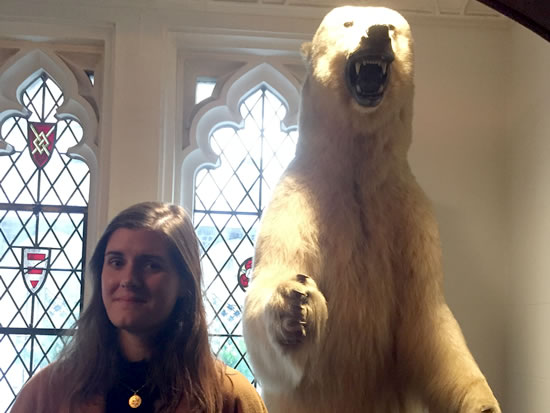Saturday Science by Molloy College
By Margaux MontAgner

Margaux Montagner get acquainted with the polar bear who resides at the Explorer's Club
Saturday, December 8th marked the last “Saturday Science for Students” of the season. Organized by Molloy College’s Center For Environmental Research and Coastal Oceans Monitoring (CERCOM) and the Explorer's Club, the series of conferences features scientists from different fields presenting their career paths and their research to high-school students. With temperatures barely reaching the 30s that Saturday morning, parka-clad teenagers streamed in the holiday-decorated conference room, with wreaths adorning the antique stained-glass windows, to hear about environmental engineering with Dr. Mark Ringenary.
An enthusiastic and energetic speaker, Dr. Ringenary started his conference by confessing to his audience that he had little plans for the future when he was their age: “In high school, I actually wasn’t even planning on going to college. (...) I just didn’t know what I wanted to do”. He instead chose to focus on mechanics and woodwork. After graduating, however, he still chose to further his education, as he enjoyed learning, and earned a degree in biology while working in landscaping to finance his studies. Once he earned his degree in 1997, Dr. Ringenary had difficulties finding work, as he lacked relevant experience — he advised the crowd to do internships and volunteer as much as possible, as to not repeat his mistakes. As he was a bit at a loss, he decided to apply for work in the medical field for laboratory work, eventually becoming a medical technologist.
His work led him to various fields, such as hematology, immunobiology, and microbiology while earning a masters in medical technology. He planned to go to medical school afterwards, but none of his applications panned out: “That was a bust for me”, he laughed. “I just wasn’t doctor material, I guess”. Dr. Ringenary then had to choose between different fields for the next step in his career: medical and veterinary, computer science or environmental science. He picked the latter, as he believed it would give him more opportunities for field work, rightfully so, and started working for the Parks services in ‘97, which he recommends, as it had been very supportive of his continued education and research. Now based at the Gateway National Recreation Area, or Gateway NRA, with units in Sandy Hook, New Jersey, Staten Island and Jamaica Bay, his research centers on limnology, the study of inland aquatic ecosystems, among other fields.
Jamaica Bay is of particular interest for his work, with wildlife refuges, landfills, and sewage treatment plants within short distances of each other. Over three hundred different bird species come through the bay, such as the Piping Plover, making it popular with the Audubon Society as well. Dr. Ringenary presented part of his work in the bay on the effects of pollution and water quality on wildlife. “Everything we do has an impact on our estuaries and our ecosystem”, he noted. If the water coming out of treatment plants contains too much nitrogen and nutrients, for instance, too much algae would grow and then decay, causing a drop in oxygen levels. His research also focused on the effects of lead concentration in water, which was eventually used for Flint, Michigan residents in their fight for clean water.
An event of note also occurred this year in Jamaica Bay: a Kemp’s Ridley sea turtle, the most endangered sea turtle species in the world, laid eggs on the Rockaway Peninsula. Such behavior had never been observed before, as these turtles typically nest in the Gulf of Mexico — a testament to the Parks department’s effort in keeping the bay a haven for wildlife. One hundred ten eggs were eventually saved and incubated before high tides and Nor’easters could endanger them. Ninety-six hatchlings survived, and were eventually released on West beach, an unforgettable moment for the agency — the kind of moment that could definitely attract young students to a career in the environmental science. #
The next session of conferences will start next Spring at the Explorer's Club, among other events tailored for a younger audience. Since last September, students attending the Saturday Science talks got to learn about conservation biology, genetics, and developmental biology.
